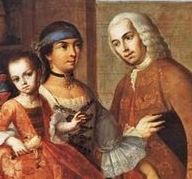| En Español |
Home |
Search |
Nobility |
Trees |
Sources |
Articles |
|
Chronology of Francisco
Pizarro's Children
 Introduction But, who were his parents? Where was he
born? Who was his wife and who were her
parents? Where did their parents come
from? These are the questions that we have
been unable to answer. Until we do, the
Pizarros of Loja will be unable to claim the
rich heritage and ancestry of the Spanish
Pizarros. Some of the descendants of Juan Pizarro are
sure that he was Juan Pizarro Yupanqui, the son
of Francisco Pizarro and his Inca partner
Cuxirimay Occlo Yupanqui, better known in
history by the name given to her by the
Spaniards: Angelina. The family
histories of Juan Pizarro's descendants
say this is so. But the historical
evidence available to date supports the theory
that Juan Pizarro Yupanqui died in infancy, most
likely prior to age 4. We presented the
available evidence in our report on the
Pizarro and Yupanqui families. Recently, we discovered a document that
proves that Juan Pizarro Yupanqui was still
alive at age 3. It raises the possibility
that the historical documents are wrong and that
Juan Pizarro Yupanqui may have survived his
infancy. The document is a notarized
statement made in Lima, Perú on April 4, 1543 by
Gonzalo Pizarro, brother of the deceased
Francisco Pizarro. The statement appoints
Francisco de Robles as administrator of
Gonzalo's encomienda in Guaylas (Huaylas),
Perú. Gonzalo affirms that he is the
guardian of the children of Francisco Pizarro,
and that they are being sent to live at the
Guaylas encomienda under the care of Francisco
de Robles. Francisco Pizarro's children
are identified by name and include "Joan
Piçarro". In addition to this document, we have
discovered several other contemporaneous
documents that refer to the minor children of
Francisco Pizarro. Some identify the
children by name, but most mention the children
collectively, creating a lack of clarity
regarding which children were included in the
events recorded. We have collected and
reviewed these documents to try to answer the
question: What happened to the children of
Francisco Pizarro? In trying to answer this question, we have
decided to present the available evidence in
chronological form, child by child, to get a
sense of where they were and what happened to
them in the years following the assassination of
Francisco Pizarro on June 26, 1541. The children of Francisco Pizarro, conqueror of
Perú, were:
For example, Francisco Pizarro, conqueror of Perú, was also identified in historical records as the Marquess or the Governor. He was the first Governor of New Castile. He was never Viceroy of Perú, even though some online trees identify him as such. His brothers who came to the New World and also were conquistadors were named Hernando, Gonzalo and Juan Pizarro, and Francisco Martín de Alcántara. So the same names are found among the children and the brothers of Francisco Pizarro the conquistador. Chronology
Analysis The evidence we have collected in our
chronological study does not resolve the
question of whether Juan Pizarro Yupanqui
survived until adulthood. But it does give
us some more clues as to where we may find the
answer. Evidence and arguments against survival
Update September 2017 - Found Original of
Hernando Pizarro's 1544 Letter My contact with the Huntington Library was
successful. They found Hernando
Pizarro's original letter of December 2,
1544. To ensure that we were able to read
the letter clearly and in its entirety, I hired
paleographic experts to prepare a transcription using
Modern Spanish spelling. Those of you who
speak Spanish can judge Hernando's words for
yourselves, but in essence, the translation made
by the Huntington Library was correct. It
is very clear in Spanish that Hernando was
speaking of Francisco Pizarro's children.
When he speaks of the "one who died", it is
clear that he could only be referring to Juan,
since Gonzalo didn't die until 1546. The letter does swing the weight of the
evidence against survival. However, it is
not conclusive. Juan's mother Cuxirimay,
or some other relative, may have falsified
Juan's death to protect him, and lied to
Gonzalo, who misinformed Hernando. Or
Gonzalo could have been in on the plot to hide
Juan, and deliberately mislead Hernando. Conclusive evidence would be that Juan died on
such a date and in such a place, and from such a
cause. Perhaps it does not exist. What we need is proof that Juan Pizarro Yupanqui was alive at some time after 1543. I have looked for such evidence, as have other researchers, and we have not found it. I plan to continue searching, either for proof that Juan Pizarro Yupanqui lived, or if not, for proof of the identity and ancestry of the Juan Pizarro of Loja. Some potential sources of such evidence are:
I plan to continue searching for these records, though some years may pass before I am able to make research trips to Loja, Gonzanamá and Huaylas. If any reader is able to find any of these records, we will greatly appreciate your sharing them with us.
|